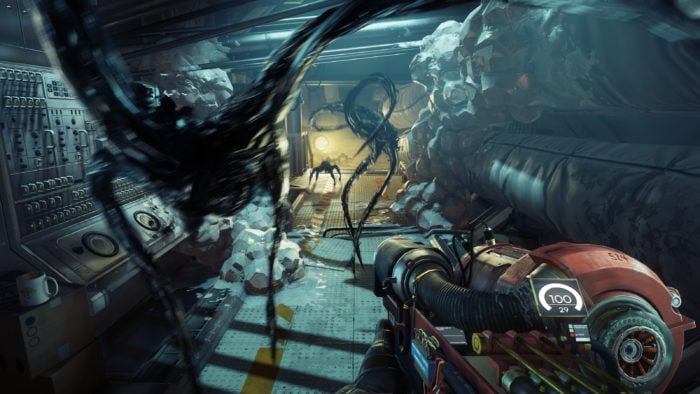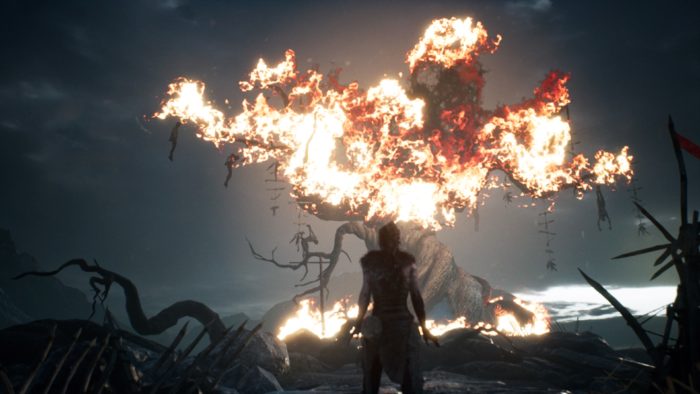Prey

Mimics are just…the worst. These shape shifting piles of black goo are the first types of enemies that the player encounters in Prey, and they only become bigger, scarier, and cleverer as the narrative progresses. They aren’t incredibly easy to kill either. They’re fast and agile, and can kill Morgan fairly quickly if they gang up and surround them. Their shape shifting nature means that they could be anything in the world, and I do mean anything. That trashcan? Could be a Mimic. That chair? Could be a Mimic. That coffee cup? Yup, you guessed it. Every object is a potential threat and the player can never afford to lower their guard.
Prey is also pretty terrifying in how it twists how the player perceives himself or herself. At the beginning of the game, the player is asked, through Morgan, a series of questions. They’re primarily about trying new things, weighing the good of the few in comparison to the many, and self-sacrifice. The game itself then throws the player into these situations, forcing them to choose between familiar human powers or new alien powers, saving the individuals on the station or destroying the alien threat, and saving himself or herself or making a sacrifice for the greater good. By the game’s end, players are confronted with their true moral code, and the horrifying truth that they may have never truly known themselves.
Hellblade: Senua’s Sacrifice

An action-adventure, Hellblade: Senua’s Sacrifice strips player’s of their sanity by pushing them into the shoes of someone with Schizophrenia. It’s not fun. What’s real? Which voice should be listened to? Games are meant to empower players, but Hellblade goes to great lengths to take that power away, and force players to question the dark, oppressive world around Senua in a way that players usually don’t have to in other games. When there’s nothing concrete to latch onto, the only thing left should be the mind.
After all, “I think, therefore I am.” However, without a stable mind to latch onto, the player is left to struggle forward against odds they can’t even be sure are real.
Bioshock

I can still vividly remember the opening to the original Bioshock, mostly because, after a Slicer skittered across the hull of the underwater elevator, I had no desire to leave my safety bubble. Marketing itself as a first-person shooter, Bioshock preys on a player’s fear of the unknown to great effect. Everything about the game’s setting, from the decayed remnants of society to the monstrous creatures that still inhabit it, are designed to make the player feel uneasy.
It certainly doesn’t help that the player is pretty much always at a disadvantage when it comes to fighting. Bullets are scarce and the energy for the supernatural powers is limited. The lumbering Big Daddies tank anything the player throws at them, and deal punishingly amounts of damage in return. Scavenging for resources and resorting to hit-and-run tactics in order to survive is the player’s only option. There are few situations that make players feel as powerless, barring confrontations of the Big Sister in Bioshock 2.
Inside

I’ve played Inside twice now and I still have no idea what’s going on in that game. Tasked with navigating a strange underground facility that’s experimenting with the effects of mind control, this adventure game paints a bleak, almost despotic, picture. As if that wasn’t stressful enough, death comes quickly for the player, in a variety of terrifying forms. Killer dogs chase down and maul the protagonist while demonic water wraiths are eager to drown anyone in their deadly embrace.
But it’s the not knowing that’s most terrifying. The game never shows its hand, only offering bits of cryptic messages that hint at a darker truth: the protagonist may be under mind control themselves. The player is drawn ever forward, forced to confront bizarre horrors, and never knowing why. This world is one that fills us with fear, but is also intriguing enough to keep us pushing forward, even as we discover our situation becoming worse and worse. What’s wrong with us that we would do something like that? Like the rest of the game’s questions, this too goes unanswered.
The Sexy Brutale

The Sexy Brutale is probably the most straightforward game on this list. The player is being chased by an unkillable killer. That, on it’s own, would be pretty scary, but the game has player’s trying to solve mysteries at the same time. The stress of trying to focus on finding clues is only made worse by the nagging feeling that the killer somehow knows where the player is hiding, and is getting closer. It’s pretty unnerving.
The game’s cute art style is also contrasted against scenes of grisly murder and the sounds of necks snapping or someone choking on their own blood. It never reaches the levels of unease associated to something like the uncanny valley, but it definitely doesn’t feel right to be seeing one thing and hearing another. It’s unsettling, and that feeling sticks with the player throughout the game.
